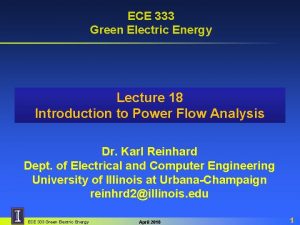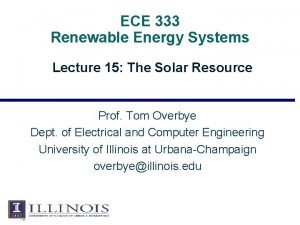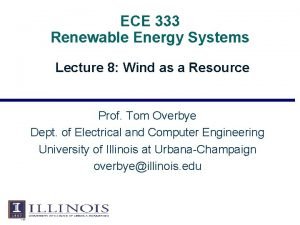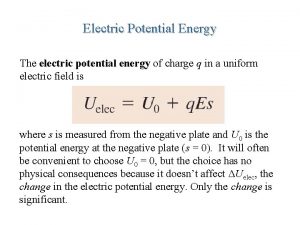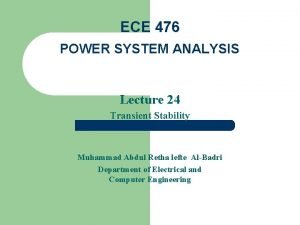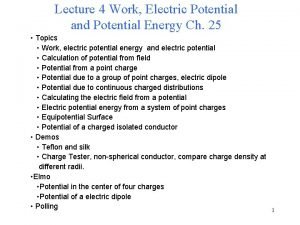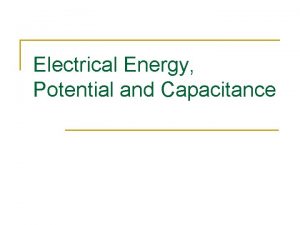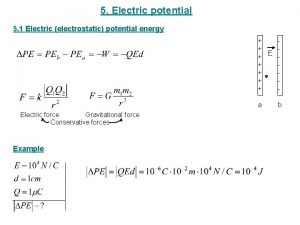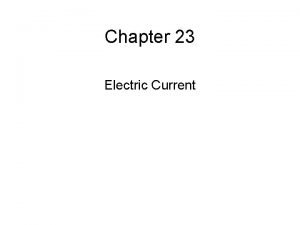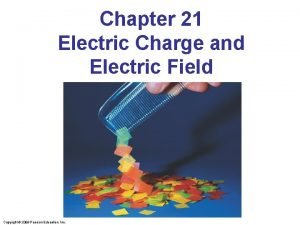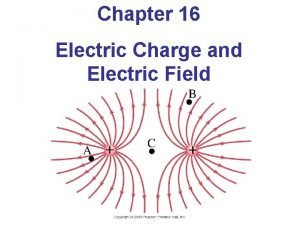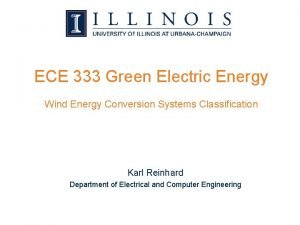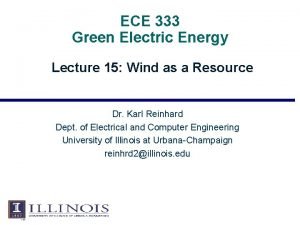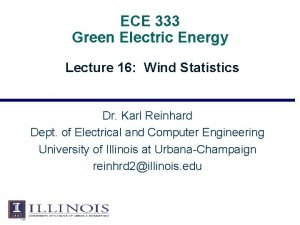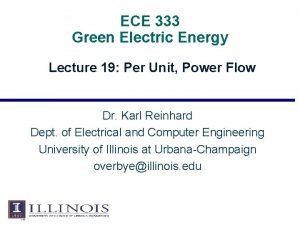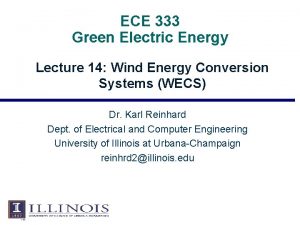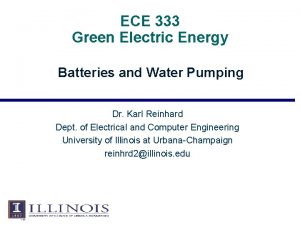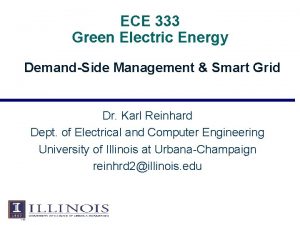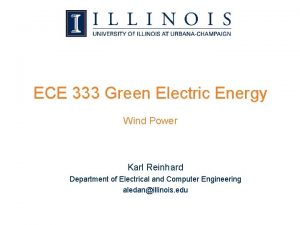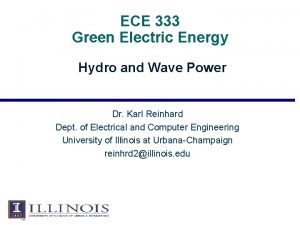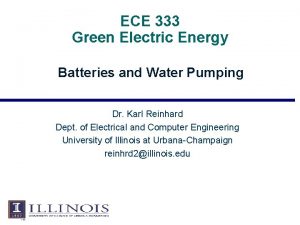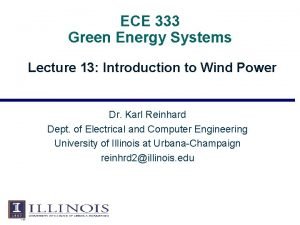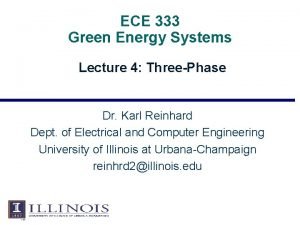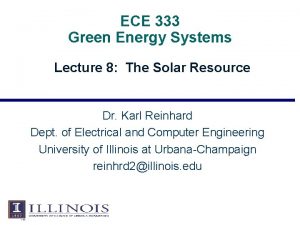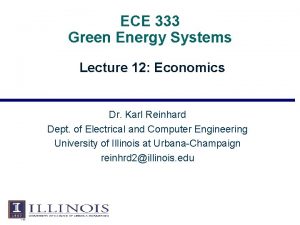ECE 333 Green Electric Energy Lecture 18 Introduction















- Slides: 15

ECE 333 Green Electric Energy Lecture 18 Introduction to Power Flow Analysis Dr. Karl Reinhard Dept. of Electrical and Computer Engineering University of Illinois at Urbana-Champaign reinhrd 2@illinois. edu ECE 333 Green Electric Energy April 2018 1

Introduction We seek to analyze the power system performance under steady state conditions. The analysis in normal steady-state operation is called a power-flow study (load -flow study) and it targets on determining the Voltages, Currents, and Real and Reactive Power Flows in a system under specified generation and load conditions. At each bus, We make an assumption about either • a Voltage at a bus or • the Power being supplied to the bus Then determine • Bus voltage magnitude and phase angles • Line currents, etc. that would result ECE 333 Green Electric Energy April 2018 2

Basics for Power-flow Studies. The way ahead…. to find the power-flow solution via iteration: 1. Create a bus admittance matrix Ybus for the power system; 2. Make an initial estimate for the voltages at each bus in the system; 3. Iterate to find conditions that satisfy the system’s load flow equations. • Update the voltage estimate for each bus (one at a time), based on the estimates for the voltages and power flows at every other bus and the values of the bus admittance matrix. • Since the voltage at a given bus depends on the voltages at all of the other busses in the system (which are just estimates), the updated voltage will not be correct. However, it will usually be closer to the answer than the original guess. 4. Repeat this process to make the voltages at each bus approaching the correct answers to within a set tolerance level… ECE 333 Green Electric Energy April 2018 3

Basics for power-flow studies The equations used to update the estimates differ for each of 3 bus types. 1. Load bus (PQ bus) – All buses not having a generator • Real and reactive power (P and Q)are specified • Bus voltage magnitude and phase angle (V and q) will be calculated • Real and reactive powers supplied to a power system are defined to be positive • Powers consumed from the system are defined to be negative. 2. Generator bus (PV bus) – • Voltage and real power supplied are specified • Bus phase angle (q) will be calculated during iteration • Reactive power will be calculated after the case’s solution is found ECE 333 Green Electric Energy April 2018 4

Basics for Power-flow Studies. 3. Slack bus (swing bus) – • Special generator bus serving as the reference bus for the power system. • Voltage is fixed – both magnitude and phase (for instance, 1 0˚ pu). • Real and reactive powers are uncontrolled – supplies whatever real or reactive power is necessary to make the power flows in the system balance. Key Points: • Voltage on a load bus (P-Q bus) changes as the load varies – P and Q are fixed, while V (magnitude and angle) vary with load conditions. • Generators (@ P-V buses) work most efficiently when running at full load – P and V are fixed • Slack bus generator varies P and Q that it supplies to balance Complex power – V and Angle reference are fixed. ECE 333 Green Electric Energy April 2018 5

Ybus for Power-flow Analysis The basic equation for power-flow analysis is derived from the nodal analysis equations for the power system: I 12 I 42 I 32 ECE 333 Green Electric Energy April 2018 6

Power-flow Analysis Equations The basic equation for power-flow analysis is derived from the nodal analysis equations for the power system: (1) For the four-bus power system shown above, (1) becomes (2) where Yij are the elements of the bus admittance matrix, Vi are the bus voltages, and Ii are the currents injected at each node. For bus 2 in this system, this equation reduces to ECE 333 Green Electric Energy April 2018 (3) 7

Ybus for Power-flow Analysis Example: a simple power system has 4 buses, 5 transmission lines, 1 generator, and 3 loads. Series per-unit impedances are: Note: Ybus symmetric construction – Off diagonal elements are -Yij = -Yji ECE 333 Green Electric Energy April 2018 line # Bus to bus Series Z (pu) Series Y (pu) 1 1 -2 0. 1+j 0. 4 0. 5882 -j 2. 3529 2 2 -3 0. 1+j 0. 5 0. 3846 -j 1. 9231 3 2 -4 0. 1+j 0. 4 0. 5882 -j 2. 3529 4 3 -4 0. 5+j 0. 2 1. 1765 -j 4. 7059 5 4 -1 0. 5+j 0. 2 1. 1765 -j 4. 7059 8

Ybus For Power-flow Analysis Example: a simple power system has 4 buses, 5 transmission lines, 1 generator, and 3 loads. Series per-unit impedances are: Note: Ybus symmetric construction – On diagonal elements: ECE 333 Green Electric Energy April 2018 line # Bus to bus Series Z (pu) Series Y (pu) 1 1 -2 0. 1+j 0. 4 0. 5882 -j 2. 3529 2 2 -3 0. 1+j 0. 5 0. 3846 -j 1. 9231 3 2 -4 0. 1+j 0. 4 0. 5882 -j 2. 3529 4 3 -4 0. 5+j 0. 2 1. 1765 -j 4. 7059 5 4 -1 0. 5+j 0. 2 1. 1765 -j 4. 7059 9

Power-flow Analysis Equations However, real loads are specified in terms of real and reactive powers, not as currents. The relationship between per-unit real and reactive power supplied to the system at a bus and the per-unit current injected into the system at that bus is: (4) where V is the per-unit voltage at the bus; I* - complex conjugate of the per-unit current injected at the bus; P and Q are per-unit real and reactive powers. Therefore, for instance, the current injected at bus 2 can be found as (5) Substituting (5) into (3), we obtain (6) ECE 333 Green Electric Energy April 2018 10

Power-flow Analysis Equations (6) ECE 333 Green Electric Energy April 2018 11

Power-flow Analysis Equations B Y G (6) ECE 333 Green Electric Energy April 2018 12

Non-Linear – Newton Raphson Solution ECE 333 Green Electric Energy April 2018 13

Information from power-flow studies The basic information contained in the load-flow output is: • All bus voltage magnitudes and phase angles w. r. t the slack bus. • All bus active and reactive power injections. • All line sending- and receiving-end complex power flows. • Individual line losses can be deduced by subtracting receiving-end complex Power from sending-end complex power. • Total system losses – deduced by summing complex power at all loads and generators and subtracting the totals. ECE 333 Green Electric Energy April 2018 14

Information From Power-flow Studies The most important information obtained from the load-flow is the system voltage profile. A power-flow program can be set up to provide alerts if the voltage at any given bus exceeds, for instance, 5% of the nominal value such voltage variations may indicate problems… • If │V│ varies greatly over the system, large reactive flows will result; this, in turn, will lead to increased real power losses and, in extreme cases, an increased likelihood of voltage collapse. • When a particular bus has an unacceptably low voltage, the usual practice is to install capacitor banks in order to provide reactive compensation to the load. ECE 333 Green Electric Energy April 2018 15
 Ece 333 uiuc
Ece 333 uiuc Ece 333 uiuc
Ece 333 uiuc Ece 333
Ece 333 Electric potential
Electric potential Yellow light
Yellow light 01:640:244 lecture notes - lecture 15: plat, idah, farad
01:640:244 lecture notes - lecture 15: plat, idah, farad Electric potential lecture
Electric potential lecture Electric potential lecture
Electric potential lecture What is this
What is this Mention the expression
Mention the expression Electric potential difference
Electric potential difference Electric field from electric potential
Electric field from electric potential A suitable electric pump in an electric circuit is a
A suitable electric pump in an electric circuit is a Chapter 21 electric charge and electric field
Chapter 21 electric charge and electric field Chapter 21 electric charge and electric field
Chapter 21 electric charge and electric field Coloumb units
Coloumb units
